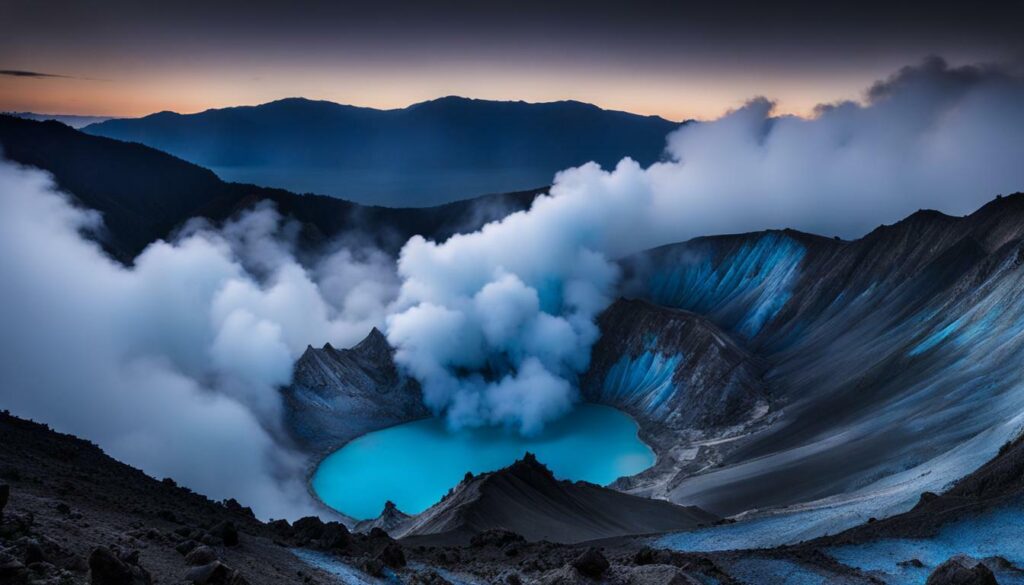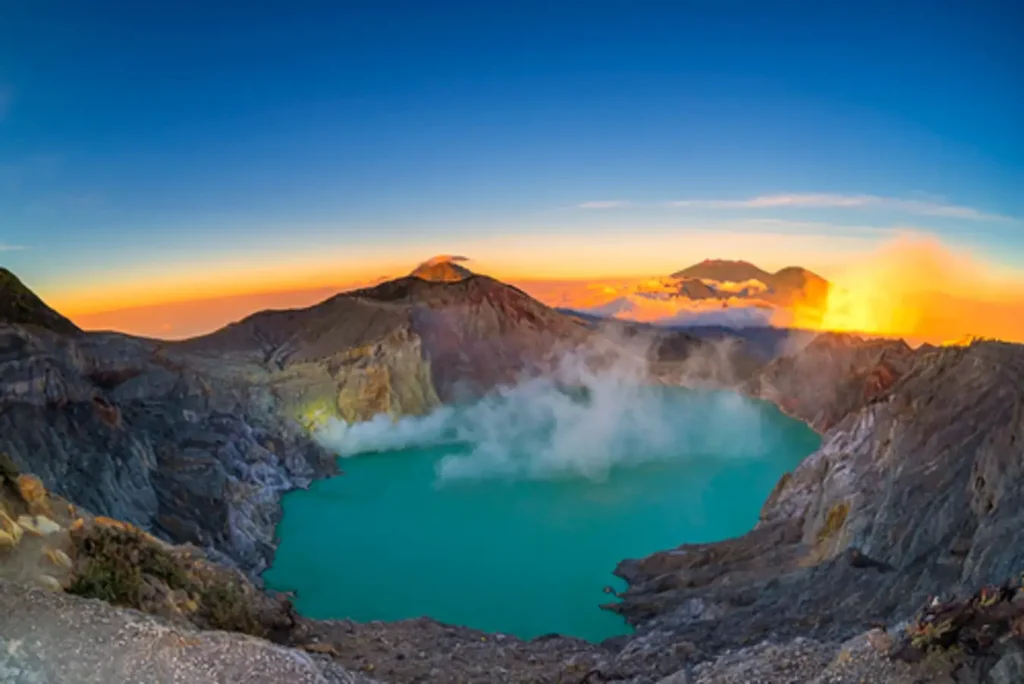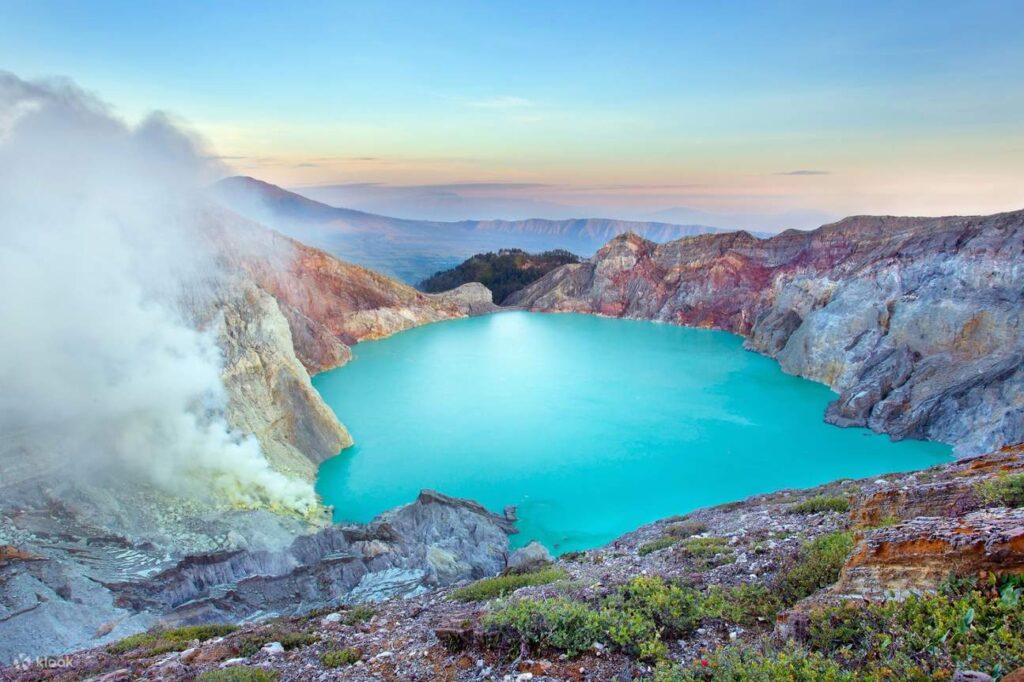Indonesia is home to some of the world’s most captivating natural wonders, and the Blue Fire Ijen Crater is no exception. Located at the Kawah Ijen volcano in East Java, this mesmerizing phenomenon is a must-see for tourists and adventure seekers alike.
The Blue Fire Ijen Crater is a rare phenomenon that occurs when sulfuric gas ignites, emitting a blue flame that illuminates the surrounding landscape in an otherworldly glow. This surreal sight has attracted visitors from all over the world, making it a popular tourist destination in East Java.
The Kawah Ijen volcano is an active volcano that last erupted in 1999. It is also home to a unique sulfur mining operation in which workers carry heavy loads of sulfur up and down the steep slopes of the volcano.
Embarking on a night hike to witness the Blue Fire phenomenon is an unforgettable experience that should not be missed. Visitors are advised to take necessary safety precautions to ensure a safe trip.
The lunar-like landscape created by the Blue Fire Ijen Crater is a visual marvel that is sure to leave visitors awe-struck. With various attractions and activities available in the area, a trip to the Blue Fire Ijen Crater is a must for anyone visiting East Java.
Key Takeaways:
- Blue Fire Ijen Crater is a captivating natural wonder in Indonesia
- The Blue Fire phenomenon is caused by sulfuric gas igniting, emitting a blue flame
- The Kawah Ijen volcano is an active volcano and home to a unique sulfur mining operation
- A night hike to witness the Blue Fire phenomenon is an unforgettable experience
- The lunar-like landscape surrounding the Blue Fire Ijen Crater is a visual marvel
Witness the Sulfuric Blue Flames: Blue Fire Ijen Crater
The Blue Fire Ijen Crater is notable for its natural blue fire phenomenon, which creates an otherworldly landscape that captivates tourists from around the world. The sulfuric blue flames result from the combustion of sulfuric gases that emerge from the Kawah Ijen volcano. The extreme heat causes the gases to ignite, producing a blue flame that is unlike anything you’ve ever seen.
The natural blue fire of the Ijen Crater is a rare occurrence, making it a must-see for anyone adventuring in East Java. The flickering flames against the dark night sky create an enchanting atmosphere that is hard to describe with words. The sulfuric blue flames and the eerie smoke that emanates from the Kawah Ijen volcano combine to create an otherworldly landscape that seems to be out of this world.
Visitors on a night hike can witness this awe-inspiring sight for themselves, getting as close as safety measures allow. The spectacle of the sulfuric blue flames is a testament to the power of nature and its ability to create truly stunning visuals.
The natural blue fire phenomenon of the Blue Fire Ijen Crater is a unique and mesmerizing sight that should be on every adventurer’s bucket list. The otherworldly landscape created by the Kawah Ijen volcano is a testament to the beauty and power of nature, and it’s something you won’t forget any time soon.
Exploring the Enigmatic Kawah Ijen Volcano
The Kawah Ijen volcano, located in East Java, is home to the captivating Blue Fire Ijen Crater. This active volcano, which last erupted in 1999, is a popular destination for tourists seeking a unique travel experience.
One of the most interesting features of the Kawah Ijen volcano is its sulfur mining practices. Local miners extract yellow sulfuric rocks by hand and carry them up and down the steep slopes of the volcano.
| Sulfur mining at Kawah Ijen | Image source |
|---|---|
| Sulfur miners carrying baskets of sulfur on their shoulders | Unsplash |
The miners work in precarious conditions, enduring toxic sulfur fumes and heavy loads, yet they continue to contribute to the local economy through their hard work.
Aside from its unique sulfur mining practices, the Kawah Ijen volcano is also known for its stunning natural beauty. The turquoise-colored crater lake and the otherworldly landscape created by the Blue Fire Ijen Crater are awe-inspiring sights to behold.
Visitors to Kawah Ijen can also enjoy hiking, trekking, and camping in the surrounding national park. The volcano’s close proximity to other popular tourist destinations in East Java, such as Mt. Bromo and Bali, makes it a convenient addition to any travel itinerary.
Embark on a Night Hike to Witness the Blue Fire Phenomenon
For those seeking a truly memorable experience, a night hike to witness the blue fire phenomenon at the Ijen Crater is an absolute must. This unique natural spectacle can only be observed in the early hours of the morning, making the hike an exciting adventure for visitors.
Before embarking on the hike, it is important to be well-prepared. Tourists are advised to wear warm clothing and sturdy shoes, as the terrain can be rugged. A guide is also recommended, as the hike can be challenging and it is important to follow safety guidelines.
As hikers reach the summit of the Ijen Crater, they are greeted by the awe-inspiring sight of the sulfuric blue flames. The natural occurrence of the blue fire is due to the combustion of sulfuric gases, creating a mystical and surreal atmosphere.
Visitors are advised to keep a safe distance from the flames, as they can reach temperatures of up to 600 degrees Celsius. However, the experience of witnessing the blue fire phenomenon amidst the lunar-like landscape of the Ijen Crater is truly unforgettable.
The night hike to witness the blue fire phenomenon at the Ijen Crater is a unique and exhilarating experience that draws tourists from around the world. It is an opportunity to witness the power and beauty of nature, and to create lasting memories that will be cherished for a lifetime.
Marvel at the Lunar-Like Landscape of Blue Fire Ijen Crater
The Blue Fire Ijen Crater is more than just a natural wonder; it also boasts a unique lunar-like landscape that captivates visitors. The bright blue flames from the sulfuric gas ignited by the volcano create an otherworldly atmosphere, adding to the allure of the place.
As you approach the crater, you’ll be struck by the stark contrast between the deep blue flames and the surrounding darkness. The smoke billowing from the volcano, combined with the striking sulfur deposits on the ground, enhance the lunar-like quality of the landscape.
The experience of marveling at this awe-inspiring landscape is a must-do for travelers to East Java, Indonesia. The Blue Fire Ijen Crater is quickly becoming a popular tourist destination for adventurous travelers looking to discover the incredible beauty of the world’s natural wonders.
- Take in the stunning lunar-like landscape created by the Blue Fire Ijen Crater.
- Witness the awe-inspiring sulfuric blue flames, adding to the beauty of the landscape.
- Experience the striking contrast between the blue flames and the surrounding darkness.
Aside from the Blue Fire Ijen Crater, East Java is a region rich in culture and history, offering a variety of activities and attractions for tourists. Visitors can explore ancient temples, hike to waterfalls, or enjoy the unique cuisine and hospitality of the locals.
Adding the Blue Fire Ijen Crater to your travel plans is a must-do experience, and we highly recommend making the trip to witness this lunar-like landscape for yourself.
Conclusion
The Blue Fire Ijen Crater in Indonesia is a natural wonder that is a must-see for any traveler. The captivating sulfuric blue flames and lunar-like landscape will leave you in awe. Not only is the Blue Fire Ijen Crater a stunning natural spectacle, but it also holds great significance for tourism in East Java, attracting visitors from all around the world.
If you’re up for a unique adventure, embark on a night hike to witness the blue fire phenomenon up close. Be sure to follow safety protocols and come prepared for the trek. The experience is unforgettable and will leave you with memories to last a lifetime.
When planning your trip to Indonesia, make sure to add the Blue Fire Ijen Crater to your itinerary. This otherworldly destination is not to be missed. Take the opportunity to marvel at the wonders of the world and create new memories with loved ones.
Explore the beauty of East Java tourism and discover the magic of the Blue Fire Ijen Crater.
FAQ
What causes the blue fire phenomenon at the Blue Fire Ijen Crater?
The blue fire phenomenon at the Blue Fire Ijen Crater is caused by the combustion of sulfuric gases, which ignite and produce a blue flame when they come into contact with oxygen.
Is it safe to witness the blue fire phenomenon during a night hike?
While witnessing the blue fire phenomenon can be a thrilling experience, it is important to take proper safety precautions. It is advisable to follow the guidance of experienced guides, wear protective clothing, and bring a mask to filter sulfuric gas fumes.
How long does the blue fire phenomenon last at the Blue Fire Ijen Crater?
The blue fire phenomenon at the Blue Fire Ijen Crater is visible during the night and early morning hours. It typically lasts for a few hours, starting around midnight and gradually fading as the sun rises.
Can visitors explore the Blue Fire Ijen Crater during the day?
Yes, visitors can explore the Blue Fire Ijen Crater during the day. However, the blue fire phenomenon is only visible in its full glory during the night. During the day, visitors can still marvel at the stunning lunar-like landscape and learn about the sulfur mining practices in the area.
Are there any restrictions or permits required to visit the Blue Fire Ijen Crater?
Yes, there are certain restrictions and permits required to visit the Blue Fire Ijen Crater. Visitors are advised to check with local authorities or tour operators to ensure they have the necessary permits and comply with any regulations set in place for safety and preservation purposes.
What other attractions or activities can be enjoyed in the vicinity of the Blue Fire Ijen Crater?
In the vicinity of the Blue Fire Ijen Crater, visitors can enjoy various attractions and activities. These may include hiking trails, visits to nearby waterfalls, exploring local villages, and experiencing the unique cultural heritage of East Java. It is advisable to plan and research ahead to make the most of the visit.





